OK, this one dates back to 2015! I thought I had posted this, but realized I didn’t when I posted a picture of something else. So here it goes…
Back in 2015, I bought a pair of RCA WHP141 wireless headphones at Micro Center for $2. I even mentioned it in the best cheap/free scores thread right here. Just forgot to follow up with that.
As mentioned back then, these are (were) 900 MHz FM wireless headphones. No modern day Blutooth or anything like that. I knew they wouldn’t be great headphones or even that good… but the price was right! So let’s take a look at them in their stock form first.
So let’s take a look at them in their stock form first.
These are “over-ear” design with rotating cups.
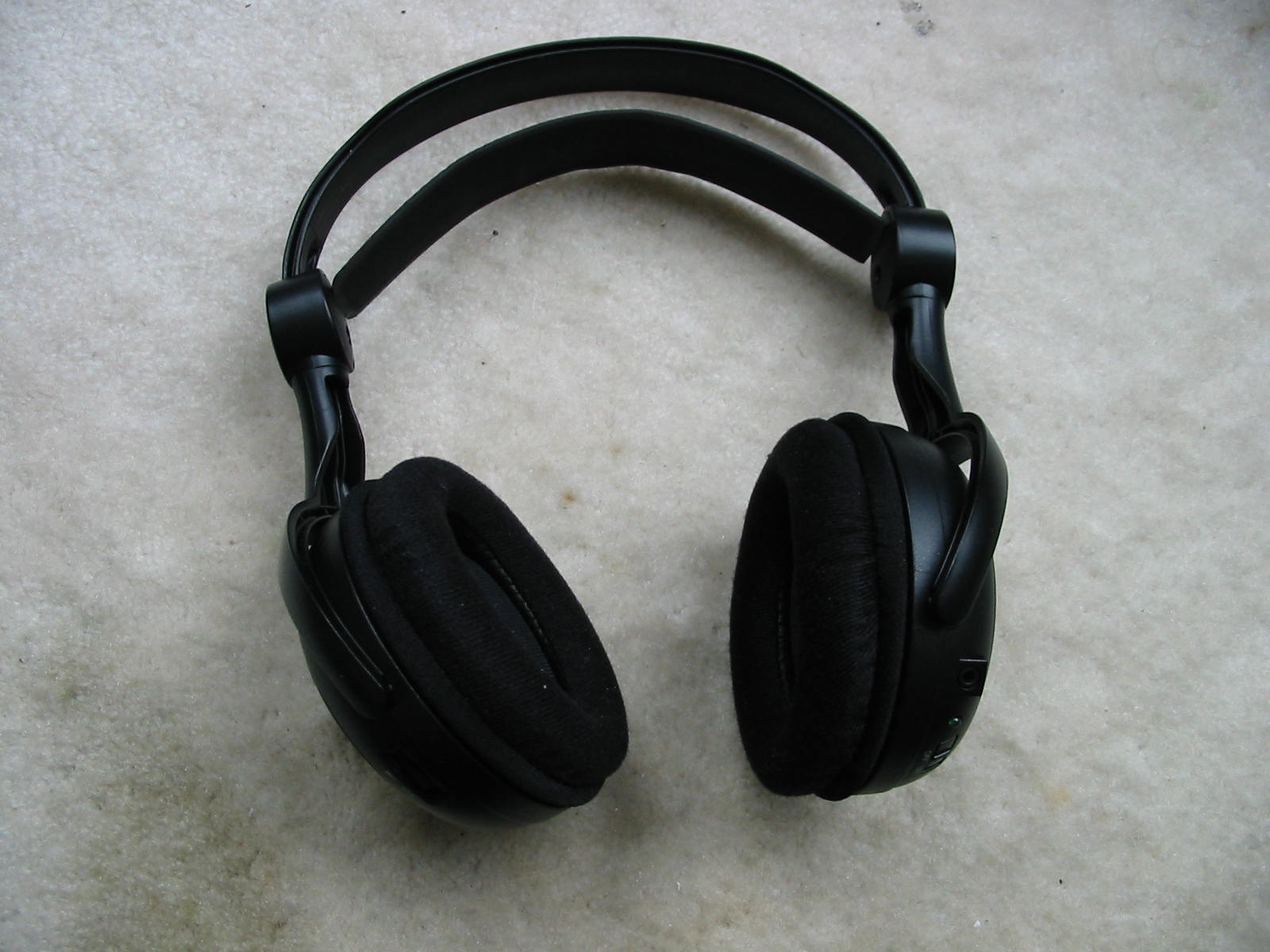
Yes, very bulky and plastic-y looking, but I can’t complain for 2 clams. They are (were) fairly comfortable and fit well on my head (albeit a bit on the loose side.)
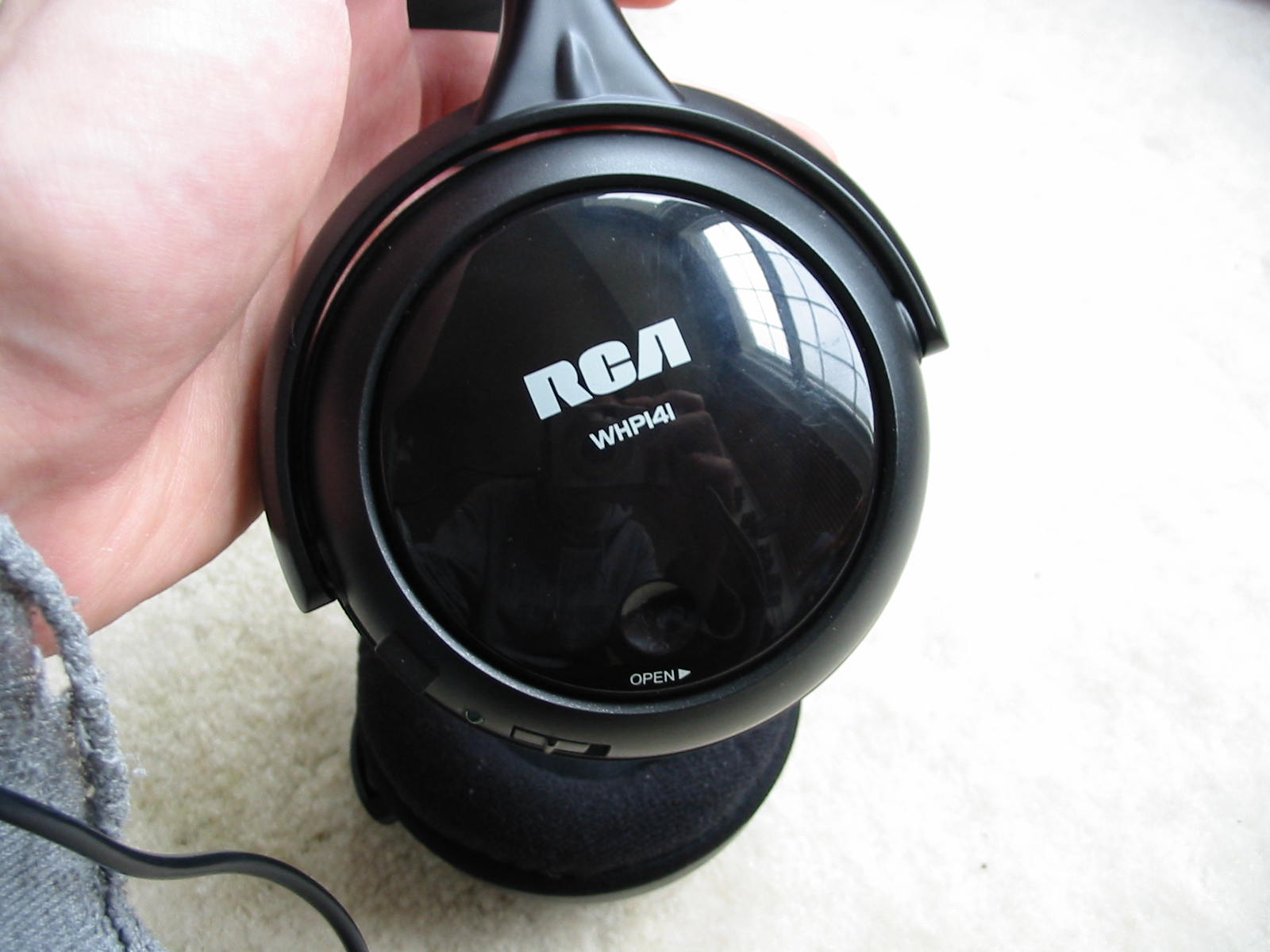
The best part, IMO: cloth ear cups! I really dislike fake/ pleather (or whatever it’s called), because it always falls apart and makes a mess after a few years. On the other hand, cloth cups are more durable… and even washable! (Though that still needs doing on my part until this day. ) The ones on the WHP141 are a little under-padded perhaps and my ears do hit the back of the cup… but overall they are comfortable.
) The ones on the WHP141 are a little under-padded perhaps and my ears do hit the back of the cup… but overall they are comfortable.
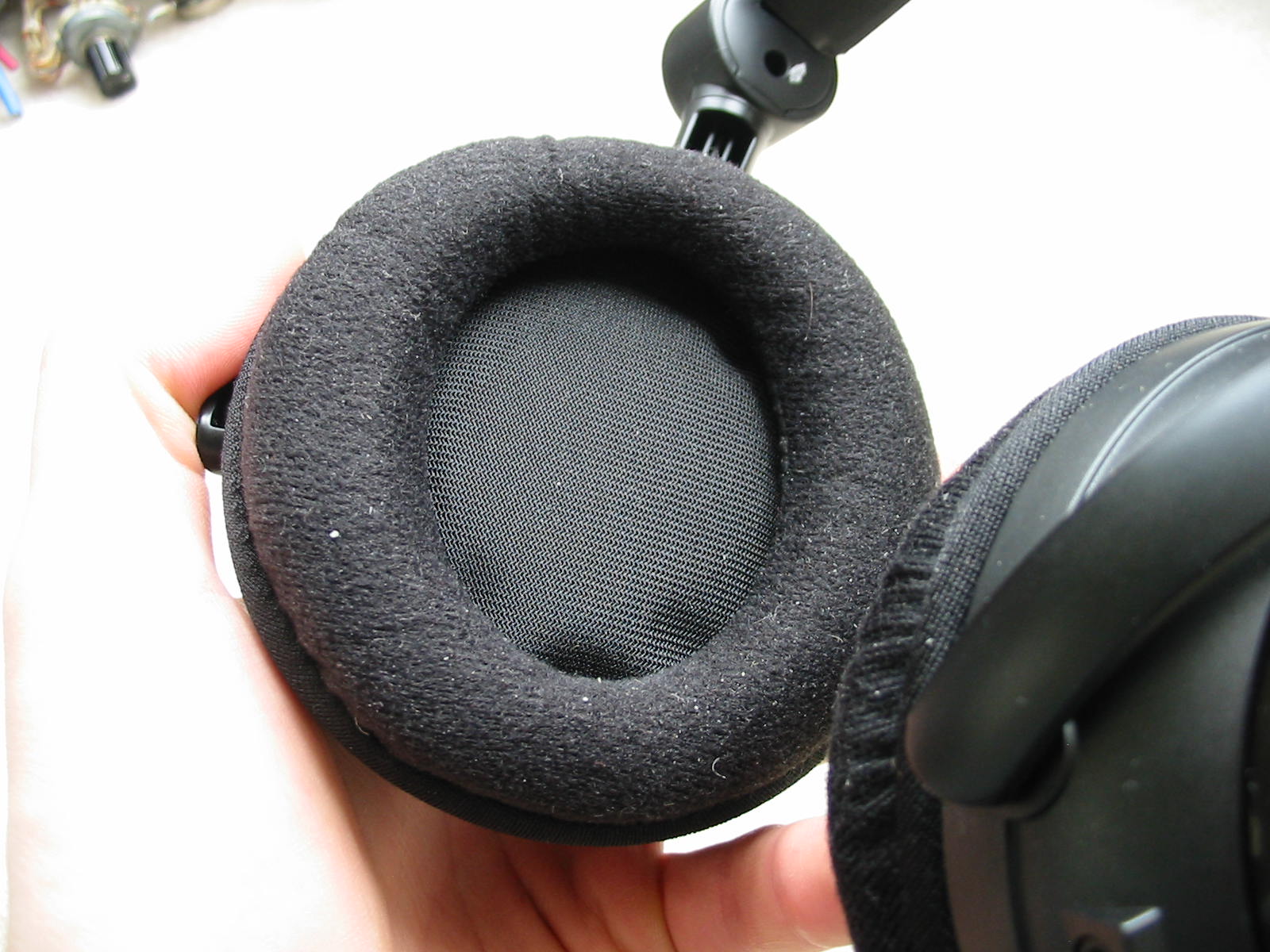
Here is another shot below, showing all of the controls on the headset. The left ear cup has a volume pot, a “Station” LED to indicate when the headphones are receiving good signal, and a channel switch (not visible in the picture) to select between 3 different FM channels in the 900 MHz range. Meanwhile, the right ear cup has the ON/OFF switch, power LED, a charger jack (slightly smaller than a headphone jack… 2-2.5 mm I believe), and is the one that holds the 2 AAA batteries.
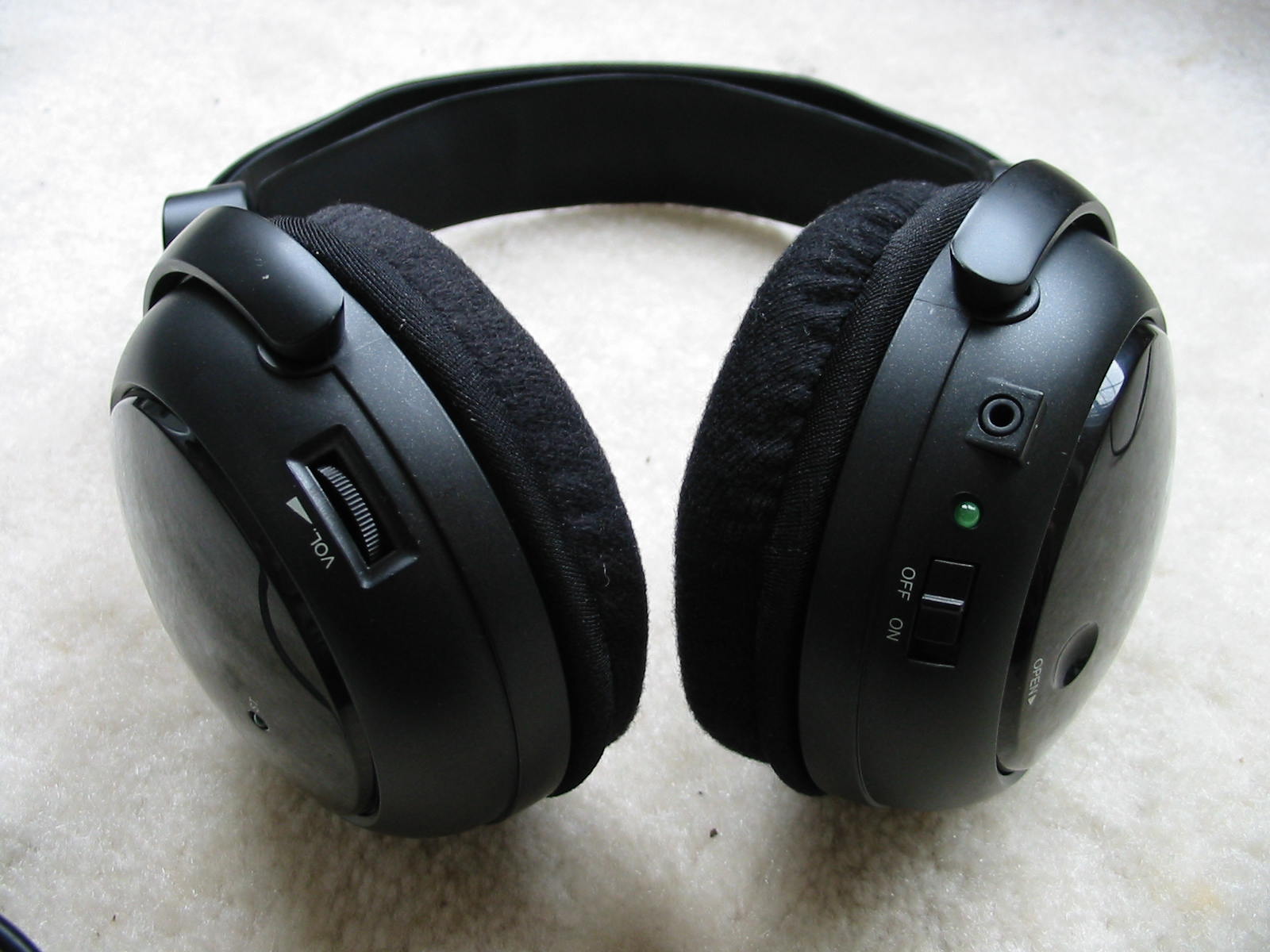
And here is the transmitter station that came with the headphones:
Again, these headphones came with the original box, all for $2 and nothing missing. The only thing I found to be missing… or lacking I should say, was the sound quality. Like any FM headphones, these were a bit noisy depending on interference, and also noisy due to the design / internal amplifier IC used for the drivers. My biggest gripe was with the bass output, though – I like heavy bass . However, the WHP141 performed about the same as my cheapo Sony MDR-023 – a design from the late 90’s that shipped with many Sony “Walkman” and’ Discman” units. So this didn’t seem quite right, considering the WHP141 have 40 mm drivers in them. My suspicion was weak amplifier in the headset and/or bandwidth-limited broadcast from the station unit. Also, I wasn’t a fan of having to charge batteries every so often to use the headphones. I’m a music junkie and when I have a week when I’m really in the mood for music, my headphones can see very heavy use for many hours.
. However, the WHP141 performed about the same as my cheapo Sony MDR-023 – a design from the late 90’s that shipped with many Sony “Walkman” and’ Discman” units. So this didn’t seem quite right, considering the WHP141 have 40 mm drivers in them. My suspicion was weak amplifier in the headset and/or bandwidth-limited broadcast from the station unit. Also, I wasn’t a fan of having to charge batteries every so often to use the headphones. I’m a music junkie and when I have a week when I’m really in the mood for music, my headphones can see very heavy use for many hours.
With that said, it was time to open these headphones and see if I can modify / improve them in any way. Actually, I kind of already anticipated I was likely going to do this as I was buying them. Nevertheless, I had to check them out in their stock form out of curiosity. But it just wasn’t going to stick.
So here it goes… to take them apart, first take the ear cups off and then remove 3 screws on the ear cup plate.
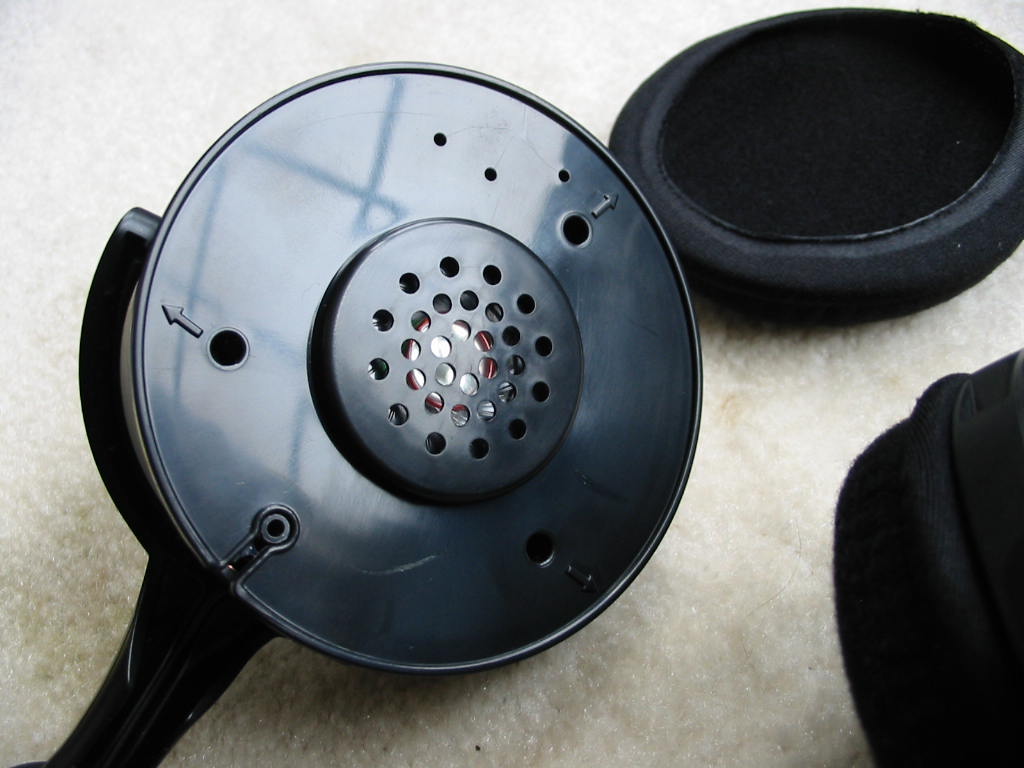
OK, done. Below is a look at the drivers. Indeed they are 40 mm size, as the box stated. Rated at 32-Ohms (pretty standard stuff) and branded “Dain”. The power rating is perhaps a little on the weak side, being only 20 mW.
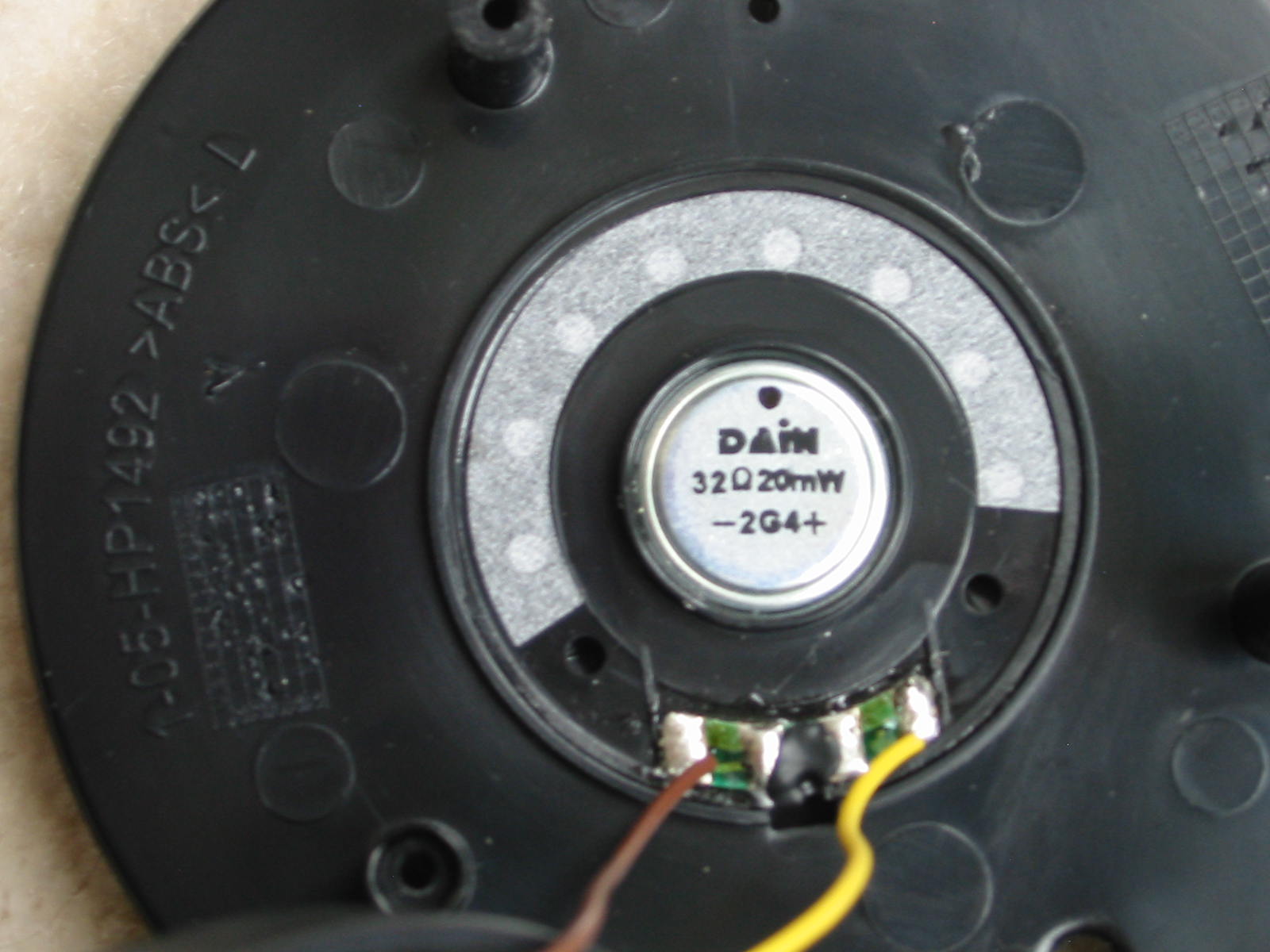
On the other side of the (now taken apart) ear cup is the PCB / electronics. Visible on the solder side is the amplifier IC (LS2308… i.e. TDA1308 -equivalent from what I found online).
And on the component side is the receiver circuit (in that metal box) and other receiver components. Not much else to it.
As can be seen above, all of the electrolytic capacitors are from a brand called “HOPE”. So I guess that means they probably have no hope of lasting long. On a related note, the output coupling capacitors are rated 4V, 220 uF, IIRC (or was it 6.3V, 100 uF?), thus being at least part of the reason why the bass output was so hopelessly bad.
On a related note, the output coupling capacitors are rated 4V, 220 uF, IIRC (or was it 6.3V, 100 uF?), thus being at least part of the reason why the bass output was so hopelessly bad. 
At first, I thought about trying to improve the circuit at hand by upgrading the output coupling capacitors. Then had some fancy ideas about adding an external 3.5 mm jack and a switch to toggle between wired or wireless operation. But the simplistic part of my mind quickly took over. So I put all “fancy” plans to the side and just wired a headphone cable with a 3.5 mm jack directly to the drivers (after disconnecting them from the onboard amplifier IC, of course.) The result was this work of “art”:

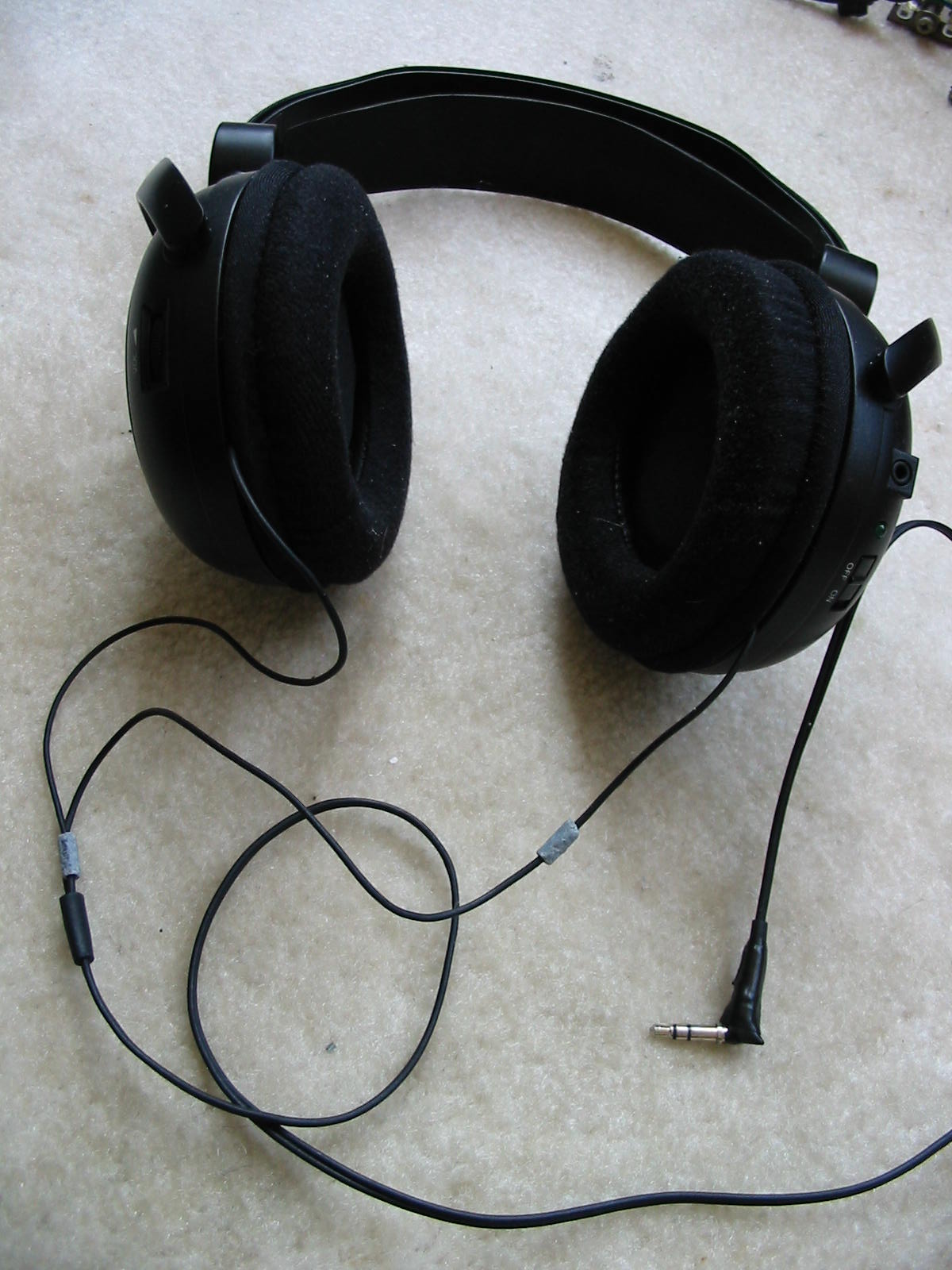
If anyone noticed how cruddy the headphone cable looks, it’s because it really is! Then again, I found this cable on the side of the road while biking to the grocery store.
Then again, I found this cable on the side of the road while biking to the grocery store.  The little ear buds that were still somehow attached to its ends were completely trashed. Those gray pieces of plastic near the “Y” split were all that is left of them (one was really stuck, so that’s why I decided to leave them both on there.) No tears shed for them, though.
The little ear buds that were still somehow attached to its ends were completely trashed. Those gray pieces of plastic near the “Y” split were all that is left of them (one was really stuck, so that’s why I decided to leave them both on there.) No tears shed for them, though.  But the 3.5 mm jack was still relatively “good” (or usable, I should say), alas a little scratched up. After taking the cable home and cleaning it thoroughly, I saved it precisely for these kinds of audio projects. And ironically enough, I found it only shortly before buying these headphones. So could we say they were meant to be together?
But the 3.5 mm jack was still relatively “good” (or usable, I should say), alas a little scratched up. After taking the cable home and cleaning it thoroughly, I saved it precisely for these kinds of audio projects. And ironically enough, I found it only shortly before buying these headphones. So could we say they were meant to be together? 
Once I put these now-modified WHP141 headphones on my head, the improvement in the sound quality was tremendous. Weak bass output – no more! The high-frequency treble also became super crisp and clear. Connecting these headphones to my hand-built AN5272 headphone amplifier made them shine even further. I could now hear much lower bass frequencies that my MDR-023 cans could have never reached… well, they could, but with lots of volume cranking, at which point I’d regularly fatigue my ears after a long session of using them. In contrast, the modified WHP141’s were pumping out more deep clean bass even at very low volume. But the clear high frequencies were one place that I didn’t even know I was missing with the MDR-023’s – the drivers in the WHP141 had so much more detail up there. The only place where I find the WHP141 drivers to lack is the limited power output. I could easily crank them into distortion with the headphone amp, particularly in the low-end frequencies. In contrast, the MDR-023’s could take a lot more power before distortion… but again, it all goes into the mid-range, thus only giving me fatigue when playing very loud. So the WHP141 were a considerable upgrade overall.
With all of that said, I still have these modified RCA WHP141 headphones and still use them on an almost daily basis… but not so much for music anymore. While they were a major step-up for me at the time over the Sony MDR-023, I found they did even better in another field that I didn’t expect: gaming and 3D acoustics. Being an “open-back” design with almost zero external noise blocking (which is ironic, given how bulky they look) and with very crisp highs, they just sounded a lot more natural in a 3D environment. I don’t know how to describe it, but I remember greatly improving my pinpointing of objects in many games, especially in Counter-Strike. In fact, I even ran into a situation in one server where a few people thought I was cheating – that’s how accurate I was at being able to tell the location of people! Also, being a little more efficient and better-balanced than the MDR-023’s, I could use them even without the headphone amplifier and still get good sound out of them. So they quickly became my “gaming” headphones… and still are to this day.
Also, being a little more efficient and better-balanced than the MDR-023’s, I could use them even without the headphone amplifier and still get good sound out of them. So they quickly became my “gaming” headphones… and still are to this day. 
They haven’t broke yet, though the flexible headband has become really hard and uncomfortable at this point.
The weak point was that 3.5 mm jack with the electrical tape – it just didn’t last very long (maybe 2-3 years with me being pretty careful with it.) So I re-soldered it and encased in hot glue, like I did with the two Dell PA-10 power adapters I showed recently. In fact, this is what made me realize I hadn’t posted these on BCN – the picture of the re-worked 3.5 mm jack, which predates the repairs of the PA-10 adapters by many years. Here it is:
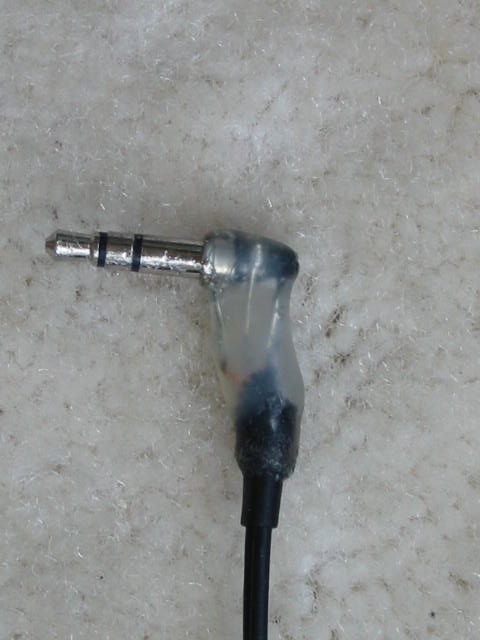
Anyways, that completes it all for these RCA WHP141 cans. I haven’t touched anything else on them since the last jack repair and they have been in regular use since then. I now use them in combination with this headset for its microphone:
https://www.badcaps.net/forum/showpo...&postcount=187
Why?
More of that will be posted about in the ghettomod thread.
Back in 2015, I bought a pair of RCA WHP141 wireless headphones at Micro Center for $2. I even mentioned it in the best cheap/free scores thread right here. Just forgot to follow up with that.
As mentioned back then, these are (were) 900 MHz FM wireless headphones. No modern day Blutooth or anything like that. I knew they wouldn’t be great headphones or even that good… but the price was right!
These are “over-ear” design with rotating cups.
Yes, very bulky and plastic-y looking, but I can’t complain for 2 clams. They are (were) fairly comfortable and fit well on my head (albeit a bit on the loose side.)
The best part, IMO: cloth ear cups! I really dislike fake/ pleather (or whatever it’s called), because it always falls apart and makes a mess after a few years. On the other hand, cloth cups are more durable… and even washable! (Though that still needs doing on my part until this day.
 ) The ones on the WHP141 are a little under-padded perhaps and my ears do hit the back of the cup… but overall they are comfortable.
) The ones on the WHP141 are a little under-padded perhaps and my ears do hit the back of the cup… but overall they are comfortable.Here is another shot below, showing all of the controls on the headset. The left ear cup has a volume pot, a “Station” LED to indicate when the headphones are receiving good signal, and a channel switch (not visible in the picture) to select between 3 different FM channels in the 900 MHz range. Meanwhile, the right ear cup has the ON/OFF switch, power LED, a charger jack (slightly smaller than a headphone jack… 2-2.5 mm I believe), and is the one that holds the 2 AAA batteries.
And here is the transmitter station that came with the headphones:
Again, these headphones came with the original box, all for $2 and nothing missing. The only thing I found to be missing… or lacking I should say, was the sound quality. Like any FM headphones, these were a bit noisy depending on interference, and also noisy due to the design / internal amplifier IC used for the drivers. My biggest gripe was with the bass output, though – I like heavy bass
 . However, the WHP141 performed about the same as my cheapo Sony MDR-023 – a design from the late 90’s that shipped with many Sony “Walkman” and’ Discman” units. So this didn’t seem quite right, considering the WHP141 have 40 mm drivers in them. My suspicion was weak amplifier in the headset and/or bandwidth-limited broadcast from the station unit. Also, I wasn’t a fan of having to charge batteries every so often to use the headphones. I’m a music junkie and when I have a week when I’m really in the mood for music, my headphones can see very heavy use for many hours.
. However, the WHP141 performed about the same as my cheapo Sony MDR-023 – a design from the late 90’s that shipped with many Sony “Walkman” and’ Discman” units. So this didn’t seem quite right, considering the WHP141 have 40 mm drivers in them. My suspicion was weak amplifier in the headset and/or bandwidth-limited broadcast from the station unit. Also, I wasn’t a fan of having to charge batteries every so often to use the headphones. I’m a music junkie and when I have a week when I’m really in the mood for music, my headphones can see very heavy use for many hours.With that said, it was time to open these headphones and see if I can modify / improve them in any way. Actually, I kind of already anticipated I was likely going to do this as I was buying them. Nevertheless, I had to check them out in their stock form out of curiosity. But it just wasn’t going to stick.
So here it goes… to take them apart, first take the ear cups off and then remove 3 screws on the ear cup plate.
OK, done. Below is a look at the drivers. Indeed they are 40 mm size, as the box stated. Rated at 32-Ohms (pretty standard stuff) and branded “Dain”. The power rating is perhaps a little on the weak side, being only 20 mW.
On the other side of the (now taken apart) ear cup is the PCB / electronics. Visible on the solder side is the amplifier IC (LS2308… i.e. TDA1308 -equivalent from what I found online).
And on the component side is the receiver circuit (in that metal box) and other receiver components. Not much else to it.
As can be seen above, all of the electrolytic capacitors are from a brand called “HOPE”. So I guess that means they probably have no hope of lasting long.
 On a related note, the output coupling capacitors are rated 4V, 220 uF, IIRC (or was it 6.3V, 100 uF?), thus being at least part of the reason why the bass output was so hopelessly bad.
On a related note, the output coupling capacitors are rated 4V, 220 uF, IIRC (or was it 6.3V, 100 uF?), thus being at least part of the reason why the bass output was so hopelessly bad. 
At first, I thought about trying to improve the circuit at hand by upgrading the output coupling capacitors. Then had some fancy ideas about adding an external 3.5 mm jack and a switch to toggle between wired or wireless operation. But the simplistic part of my mind quickly took over. So I put all “fancy” plans to the side and just wired a headphone cable with a 3.5 mm jack directly to the drivers (after disconnecting them from the onboard amplifier IC, of course.) The result was this work of “art”:


If anyone noticed how cruddy the headphone cable looks, it’s because it really is!
 Then again, I found this cable on the side of the road while biking to the grocery store.
Then again, I found this cable on the side of the road while biking to the grocery store.  The little ear buds that were still somehow attached to its ends were completely trashed. Those gray pieces of plastic near the “Y” split were all that is left of them (one was really stuck, so that’s why I decided to leave them both on there.) No tears shed for them, though.
The little ear buds that were still somehow attached to its ends were completely trashed. Those gray pieces of plastic near the “Y” split were all that is left of them (one was really stuck, so that’s why I decided to leave them both on there.) No tears shed for them, though.  But the 3.5 mm jack was still relatively “good” (or usable, I should say), alas a little scratched up. After taking the cable home and cleaning it thoroughly, I saved it precisely for these kinds of audio projects. And ironically enough, I found it only shortly before buying these headphones. So could we say they were meant to be together?
But the 3.5 mm jack was still relatively “good” (or usable, I should say), alas a little scratched up. After taking the cable home and cleaning it thoroughly, I saved it precisely for these kinds of audio projects. And ironically enough, I found it only shortly before buying these headphones. So could we say they were meant to be together? 
Once I put these now-modified WHP141 headphones on my head, the improvement in the sound quality was tremendous. Weak bass output – no more! The high-frequency treble also became super crisp and clear. Connecting these headphones to my hand-built AN5272 headphone amplifier made them shine even further. I could now hear much lower bass frequencies that my MDR-023 cans could have never reached… well, they could, but with lots of volume cranking, at which point I’d regularly fatigue my ears after a long session of using them. In contrast, the modified WHP141’s were pumping out more deep clean bass even at very low volume. But the clear high frequencies were one place that I didn’t even know I was missing with the MDR-023’s – the drivers in the WHP141 had so much more detail up there. The only place where I find the WHP141 drivers to lack is the limited power output. I could easily crank them into distortion with the headphone amp, particularly in the low-end frequencies. In contrast, the MDR-023’s could take a lot more power before distortion… but again, it all goes into the mid-range, thus only giving me fatigue when playing very loud. So the WHP141 were a considerable upgrade overall.
With all of that said, I still have these modified RCA WHP141 headphones and still use them on an almost daily basis… but not so much for music anymore. While they were a major step-up for me at the time over the Sony MDR-023, I found they did even better in another field that I didn’t expect: gaming and 3D acoustics. Being an “open-back” design with almost zero external noise blocking (which is ironic, given how bulky they look) and with very crisp highs, they just sounded a lot more natural in a 3D environment. I don’t know how to describe it, but I remember greatly improving my pinpointing of objects in many games, especially in Counter-Strike. In fact, I even ran into a situation in one server where a few people thought I was cheating – that’s how accurate I was at being able to tell the location of people!
They haven’t broke yet, though the flexible headband has become really hard and uncomfortable at this point.
The weak point was that 3.5 mm jack with the electrical tape – it just didn’t last very long (maybe 2-3 years with me being pretty careful with it.) So I re-soldered it and encased in hot glue, like I did with the two Dell PA-10 power adapters I showed recently. In fact, this is what made me realize I hadn’t posted these on BCN – the picture of the re-worked 3.5 mm jack, which predates the repairs of the PA-10 adapters by many years. Here it is:
Anyways, that completes it all for these RCA WHP141 cans. I haven’t touched anything else on them since the last jack repair and they have been in regular use since then. I now use them in combination with this headset for its microphone:
https://www.badcaps.net/forum/showpo...&postcount=187
Why?
More of that will be posted about in the ghettomod thread.


 wonder which thread I should post that in. It definitely fits the description of "hand-made" / ghetto.
wonder which thread I should post that in. It definitely fits the description of "hand-made" / ghetto.
Comment